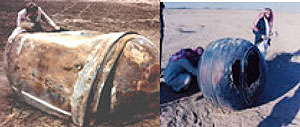Orbital debris is any man-made object in orbit above the Earth which no longer serves a useful purpose. Derelict spacecraft and upper stages of launch vehicles, carriers for multiple payloads, debris intentionally released during spacecraft separation from its launch vehicle or during mission operations, debris created as a result of spacecraft or upper stage explosions or collisions, solid rocket motor particles, and tiny flecks of paint released by thermal stress or small particles created after collision impacts.


Orbital debris is any man-made object in orbit above the Earth which no longer serves a useful purpose.
Derelict spacecraft and upper stages of launch vehicles, carriers for multiple payloads, debris intentionally released during spacecraft separation from its launch vehicle or during mission operations, debris created as a result of spacecraft or upper stage explosions or collisions, solid rocket motor particles, and tiny flecks of paint released by thermal stress or small particles created after collision impacts.
Approximately 19,000 objects larger than 10 cm are said to exist. The estimated population of particles between 1cm and 10 cm in diameter is approximated to 500,000. The number of particles smaller than 1 cm probably is said to exceed tens of millions.
Large orbital debris bigger than 10 cm, are tracked routinely by the U.S. Space Surveillance Networks. Objects as small as 3 mm, can be detected by ground-based radars providing a basis for a statistical estimate of their numbers.
Prior to 2007, the principal source of debris was old upper-launch vehicle stages left in orbit with stored energy sources, e.g. residual propellants and high pressure fluids. The intentional destruction of the Fengyun-1C weather satellite by China in 2007 and the accidental collision of American and Russian communication satellites in 2009 greatly increased the number of large debris in orbit.
Most orbital debris resides within 2,000 km of the Earth’s surface. Within this volume, the amount of debris is said to vary significantly with altitude. The greatest concentrations of debris are found near 800 km-850 km.
In low earth orbit (below 2,000 km), orbital debris circle the Earth at speeds of 7 km to 8 km per second.
However, the average impact speed of orbital debris with another space object will be approximately 10 km/s. Consequently, collisions with even a small piece of debris would involve considerable energy.
The International Space Station (ISS) is said to be the most heavily shielded spacecraft ever flown. Critical components, e.g. habitable compartments and high pressure tanks, will normally be able to withstand the impact of debris as large as 1 cm in diameter. ISS also has the capability of maneuvering to avoid tracked objects.
The risk of a critical ISS component being struck by debris 1cm to 10 cm in diameter is slight and ways to reduce this risk are being investigated.
In fact, many of the systems are being deployed in ways designed to minimize orbital debris generation. Often, upper stages and spacecraft are placed in lower altitude orbits after their missions have been completed to accelerate their fall back to Earth.
The higher the altitude, the longer the orbital debris will typically remain in Earth orbit. Debris left in orbits below 600 km normally fall back to Earth within several years. At altitudes of 800 km, the time for orbital decay often is measured in decades. Above 1,000 km, orbital debris is said to normally continue circling the Earth for a century or more.
A significant amount of debris does not survive the severe heating which occurs during reentry into the Earth’s atmosphere. Components which do survive are most likely to fall into the oceans or other bodies of water or onto sparsely populated regions like the Canadian Tundra, the Australian Outback, or the Siberian desert in the Russian Federation.
Operational spacecraft are struck by very small debris routinely with little or no effect. Debris shields can also protect spacecraft components from particles as large as 1 cm in diameter. The probability of two large objects less than 10 cm in diameter accidentally colliding is very low.
The worst such incident occurred on 10 February 2009 when an operational U.S. Iridium satellite and a derelict Russian Cosmos satellite collided. However orbital debris poses a risk to continued reliable use of space-based services and operations and to the safety of persons and property in space and on Earth in the near future.
Manufacturers and operators of U.S. spacecraft and other countries are aware of the hazards of orbital debris and the need to mitigate its growth. Many firms voluntarily adhere to measures designed to limit the growth of orbital debris and other countries have also followed suit like Russia, Japan, France, and the European Space Agency.
Ends


